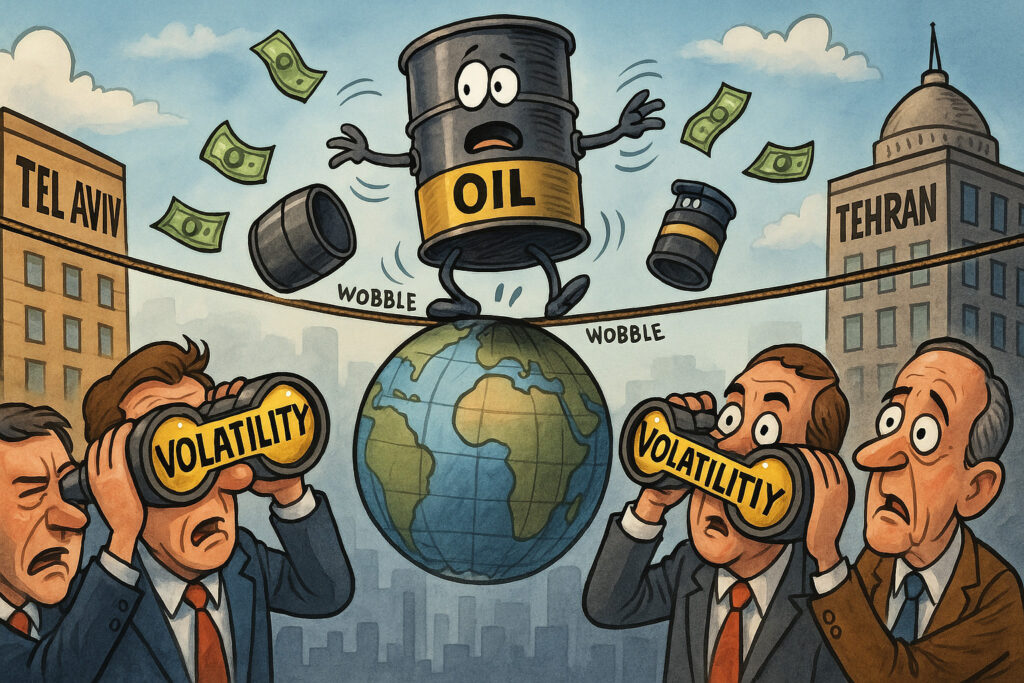Introduction
On June 16, 2025, financial markets responded with heightened caution as renewed military activity between Israel and Iran raised fears of prolonged regional instability and disruptions to global energy supplies. Reports of targeted strikes near key infrastructure hubs—though not officially confirmed by governments—sparked a surge in oil prices, increased volatility, and a rotation toward defensive assets.
The geopolitical developments coincided with the final day of the G7 summit in Ottawa, where leaders expressed concern over escalating tensions and pledged coordinated monitoring of energy and security risks. The potential for escalation added a layer of complexity to otherwise improving macroeconomic and monetary policy trends, placing renewed emphasis on geopolitical risk management in global portfolios.
This article analyzes the impact of the escalating Middle East tensions on commodity markets, equities, fixed income, and central bank strategy as investors reassess risk exposure.
Oil and Energy Markets: Supply Concerns Resurface
Oil prices surged as markets priced in the risk of supply chain disruption:
- Brent crude: +4.3% to $92.35/barrel
- WTI crude: +4.1% to $88.75/barrel
- Natural gas (Henry Hub): +2.6% to $2.71/MMBtu
Traders cited the vulnerability of the Strait of Hormuz and Israeli refinery infrastructure as key risk points. U.S. strategic petroleum reserve (SPR) monitoring intensified, and OPEC+ stated it was “ready to ensure market stability.”
Energy equities rallied:
- XLE (Energy ETF): +3.8%
- ExxonMobil: +4.2%
- Chevron: +3.9%
However, volatility in crude futures (OVX Index) rose 22%, signaling uncertainty over the situation’s trajectory.
Equity Markets: Defensive Rotation
Global equities edged lower, led by declines in risk-sensitive sectors:
- S&P 500: -0.4% to 5,185.42
- Nasdaq Composite: -0.6% to 16,142.39
- Dow Jones: -0.2% to 39,190.22
Underperformers:
- Airlines: Delta (-5.1%), United (-4.8%)
- Consumer Discretionary: -1.2%
Outperformers:
- Utilities: +0.7%
- Healthcare: +0.5%
- Defense contractors: Lockheed Martin (+3.5%), Raytheon (+2.9%)
Volatility increased, with the VIX rising to 17.5 (+11%) and short-term put options seeing elevated demand.
Bonds: Safe-Haven Buying
Investors moved into U.S. Treasuries:
- 10-year yield: Fell 7 bps to 4.24%
- 2-year yield: Dropped 5 bps to 4.73%
The MOVE Index (Treasury volatility) rose 6%, and TIPS (inflation-protected securities) outperformed nominals. Gold also rallied +1.4% to $2,368/oz.
Currency Markets: Flight to Safety
The U.S. dollar and Japanese yen strengthened:
- DXY: +0.4% to 105.90
- USD/JPY: -0.6% to 157.2
- EUR/USD: -0.3% to 1.0685
Emerging market currencies weakened:
- Turkish lira: -1.4%
- Indian rupee: -0.6%
- South African rand: -1.2%
The Swiss franc and gold-backed stablecoins also saw safe-haven demand.
Central Bank Implications: Complicating the Path
The Federal Reserve’s path to easing may face new challenges if sustained oil price inflation emerges. Analysts noted:
- Potential upward pressure on core goods inflation
- Renewed uncertainty in energy-sensitive CPI components
Fed officials remained silent, but markets interpreted the situation as possibly delaying the first rate cut to November.
Other central banks with commodity exposure may be affected:
- BoE: May face renewed energy pass-through effects
- ECB: More cautious forward guidance likely in July
- RBI and Bank of Korea: Watching FX stability and inflation transmission
G7 Response and Diplomatic Posturing
At the Ottawa summit, G7 leaders:
- Condemned attacks and urged de-escalation
- Initiated an energy monitoring task force under IEA leadership
- Called for broader cyber-resilience coordination against hybrid threats
The White House issued a statement expressing support for Israel’s security while urging restraint. Markets remained on edge for retaliatory or tit-for-tat strikes.
Investor Strategy: Tactical Defense
Institutional investors reported portfolio shifts:
- Sector rotation: Toward staples, healthcare, defense
- Geographic rotation: Away from EMs to U.S. and Japan
- Increased hedging: via VIX calls, oil futures, and currency overlays
ETF flows showed:
- Inflows into gold, utilities, and short-duration bond ETFs
- Outflows from EM equity and travel-focused funds
Conclusion
June 16, 2025, highlighted the persistent power of geopolitics to override otherwise constructive macro trends. With the Israel–Iran situation evolving rapidly, financial markets repriced risk and rotated into safety.
Key takeaways:
- Oil prices surged on fears of supply disruption
- Risk-off sentiment drove gains in gold, Treasuries, and defensive equities
- Central banks may face new inflation variables just as easing cycles approach
Markets will closely monitor:
- Further escalation or diplomatic resolution
- Oil and gas supply impacts
- Core inflation spillovers
For now, June 16 serves as a stark reminder: even in a broadly bullish macro backdrop, geopolitical shocks can reset expectations and recalibrate risk.
